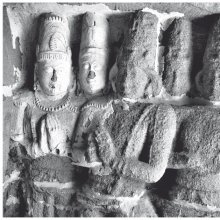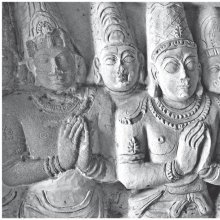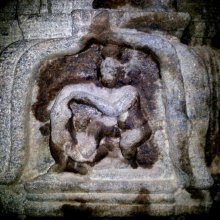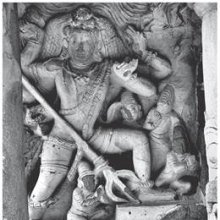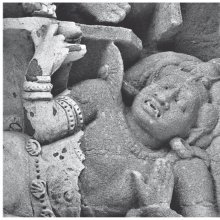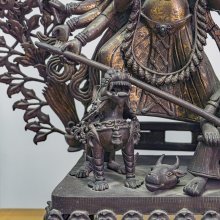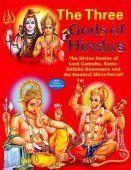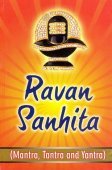Demon: 2 definitions
Introduction:
Demon means something in Buddhism, Pali, Hinduism, Sanskrit. If you want to know the exact meaning, history, etymology or English translation of this term then check out the descriptions on this page. Add your comment or reference to a book if you want to contribute to this summary article.
Images (photo gallery)
(+22 more images available)
In Hinduism
Shilpashastra (iconography)
Source: Shodhganga: Elements of Art and Architecture in the Trtiyakhanda of the Visnudharmottarapurana (shilpa)Demons refers to a certain class of personalities which follows specific guidelines in the tradition of ancient Indian Painting (citra), according to the Viṣṇudharmottarapurāṇa, an ancient Sanskrit text which (being encyclopedic in nature) deals with a variety of cultural topics such as arts, architecture, music, grammar and astronomy.—In the Viṣṇudharmottarapurāṇa, the rules of Painting of different classes have been elaborately discussed. The faces of demons should be scowling and their eyes should be round in shape.

Shilpashastra (शिल्पशास्त्र, śilpaśāstra) represents the ancient Indian science (shastra) of creative arts (shilpa) such as sculpture, iconography and painting. Closely related to Vastushastra (architecture), they often share the same literature.
In Buddhism
Tibetan Buddhism (Vajrayana or tantric Buddhism)
Source: ORA: Amanaska (king of all yogas): (Tibetan Buddhism)The Demons (in Sanskrit: Asura) can be controlled by one having the Siddhi (power) of Speech, according to verse 14.24bd-27 of the Laghuśaṃvara, an ancient Buddhist Yoginī Tantra.—Accordingly: “The Sādhaka [who has] the Siddhi of speech can certainly attract a king or queen by [merely] thinking [it]. He quickly controls gods, demons (asura) and men. When angry, he can kill with his speech and drive away his adversary. The practitioner can thus effect a curse with his speech [...]”.

Tibetan Buddhism includes schools such as Nyingma, Kadampa, Kagyu and Gelug. Their primary canon of literature is divided in two broad categories: The Kangyur, which consists of Buddha’s words, and the Tengyur, which includes commentaries from various sources. Esotericism and tantra techniques (vajrayāna) are collected indepently.
See also (Relevant definitions)
Starts with: Demonii, Demons Realm, Demontue.
Full-text (+3055): Asura, Rakshasa, Kumeru, Danu, Danava, Shambara, Camunda, Shumbha, Taraka, Mahishasura, Diti, Putana, Daitya, Shurpaka, Indrari, Kalanemi, Pherava, Purvadeva, Mandeha, Balahaka.
Relevant text
Search found 312 books and stories containing Demon; (plurals include: Demons). You can also click to the full overview containing English textual excerpts. Below are direct links for the most relevant articles:
The Agni Purana (by N. Gangadharan)
Chapter 276 - The manifestations of Lord Viṣṇu
Chapter 4 - Manifestations of Viṣṇu as the Boar
The Markandeya Purana (Study) (by Chandamita Bhattacharya)
5. Origin of Caṇḍikā Śakti < [Chapter 3]
6. Future Birth of Mahāmāyā < [Chapter 3]
3. Birth of Ambikā / Kauśikī out of Pārvati’s body < [Chapter 3]
The Skanda Purana (by G. V. Tagare)
Chapter 20 - The war between demon Kuśa and Viṣṇu < [Section 4 - Dvārakā-māhātmya]
Chapter 24 - Greatness of Kātyāyanī < [Section 3 - Arbuda-khaṇḍa]
Chapter 8 - Greatness of Three-eyed in the Pond of Bhadrakarṇa < [Section 3 - Arbuda-khaṇḍa]
The Padma Purana (by N.A. Deshpande)
Chapter 75 - The Hymn of Victory at the End of War between Gods and Demons < [Section 1 - Sṛṣṭi-khaṇḍa (section on creation)]
Chapter 102 - Jalandhara Plays a Trick < [Section 6 - Uttara-Khaṇḍa (Concluding Section)]
Chapter 81 - The Birth of Bhauma and His Worship < [Section 1 - Sṛṣṭi-khaṇḍa (section on creation)]
Lord Hayagriva in Sanskrit Literature (by Anindita Adhikari)
Hayagrīva as reflected in the Harivaṃśa < [Chapter 3]
Central Myth (6): Slaying of the demons Madhu-Kaiṭabha < [Chapter 3]
Chronological Development (3): Udyoga Parva < [Chapter 3]
Related products
